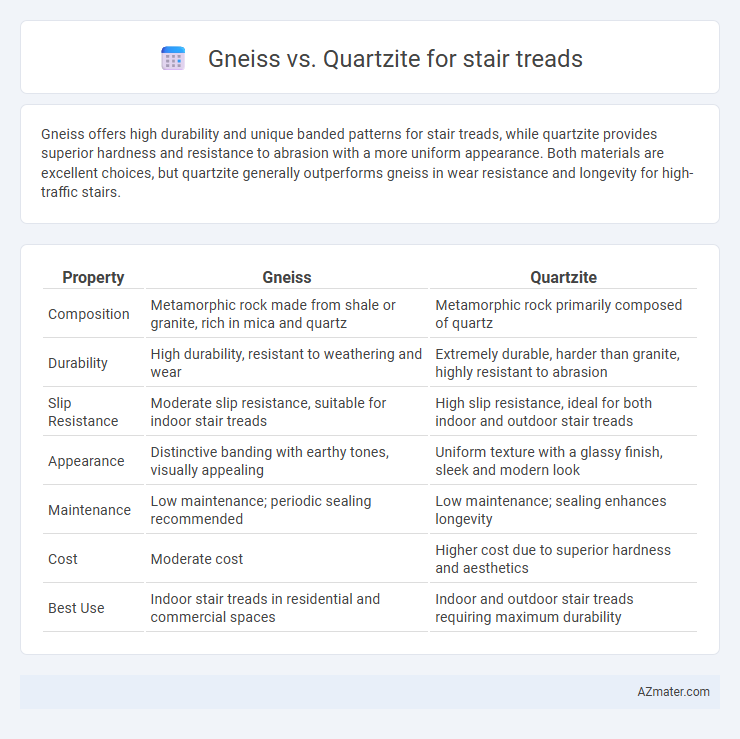Gneiss offers high durability and unique banded patterns for stair treads, while quartzite provides superior hardness and resistance to abrasion with a more uniform appearance. Both materials are excellent choices, but quartzite generally outperforms gneiss in wear resistance and longevity for high-traffic stairs.
Table of Comparison
| Property | Gneiss | Quartzite |
|---|---|---|
| Composition | Metamorphic rock made from shale or granite, rich in mica and quartz | Metamorphic rock primarily composed of quartz |
| Durability | High durability, resistant to weathering and wear | Extremely durable, harder than granite, highly resistant to abrasion |
| Slip Resistance | Moderate slip resistance, suitable for indoor stair treads | High slip resistance, ideal for both indoor and outdoor stair treads |
| Appearance | Distinctive banding with earthy tones, visually appealing | Uniform texture with a glassy finish, sleek and modern look |
| Maintenance | Low maintenance; periodic sealing recommended | Low maintenance; sealing enhances longevity |
| Cost | Moderate cost | Higher cost due to superior hardness and aesthetics |
| Best Use | Indoor stair treads in residential and commercial spaces | Indoor and outdoor stair treads requiring maximum durability |
Introduction to Gneiss and Quartzite as Stair Tread Materials
Gneiss and quartzite are durable natural stones commonly used for stair treads, valued for their strength and aesthetic appeal. Gneiss features a distinct banded texture with interlocking mineral grains, providing excellent slip resistance and wear durability. Quartzite boasts high hardness and resistance to abrasion, making it a popular choice for stair treads requiring long-lasting performance and a sleek, polished finish.
Geological Composition of Gneiss and Quartzite
Gneiss is a metamorphic rock characterized by its foliated texture and banded appearance, formed through high-grade regional metamorphism of granite or sedimentary rock, primarily composed of quartz, feldspar, and mica minerals. Quartzite originates from the metamorphism of pure quartz sandstone, resulting in an extremely hard, non-foliated rock composed almost entirely of interlocking quartz grains. The distinct geological compositions influence their durability and aesthetic appeal for stair treads, with quartzite offering superior hardness and resistance to abrasion compared to the more mineralogically diverse gneiss.
Aesthetic Differences: Color and Texture Comparison
Gneiss stair treads exhibit a banded or foliated texture with varied color patterns ranging from earthy browns and greys to subtle pinks, offering a natural, layered visual appeal. Quartzite presents a more uniform, granular texture with bright, often light shades like whites, tans, and soft pastels, providing a cleaner, modern aesthetic. The choice between the two depends on desired visual impact: gneiss suits rustic, dynamic designs, while quartzite favors sleek, contemporary looks.
Durability and Strength: Performance Under Foot Traffic
Gneiss and quartzite are both highly durable natural stones ideal for stair treads, with quartzite exhibiting superior hardness and resistance to abrasion due to its quartz-rich composition. While gneiss offers notable strength and dimensional stability, quartzite's higher Mohs hardness (7 compared to gneiss's 6-7) ensures better performance under heavy foot traffic and increased longevity. Both stones resist cracking and chipping, but quartzite is less prone to surface wear, making it a preferred choice for stair treads subjected to constant use.
Slip Resistance and Safety Considerations
Gneiss and quartzite both offer strong slip resistance for stair treads due to their natural textures and hardness, but quartzite typically provides superior traction because of its densely interlocked quartz grains. The uneven surface of gneiss adds grip but may wear unevenly over time, affecting safety. For optimal stair tread safety, quartzite is preferred in high-traffic areas due to its durability and consistently higher coefficient of friction.
Weathering and Maintenance Requirements
Gneiss exhibits higher resistance to weathering due to its foliated crystalline structure, making it less prone to surface erosion and maintaining durability in outdoor stair treads. Quartzite, composed of tightly interlocked quartz grains, offers superior hardness and exceptional resistance to chemical weathering, reducing surface degradation over time. Maintenance for gneiss typically involves regular sealing to protect against moisture infiltration, while quartzite requires less frequent sealing but benefits from periodic cleaning to retain its natural luster.
Cost Factors: Pricing Gneiss vs Quartzite Treads
Gneiss stair treads typically cost less than quartzite due to its more abundant availability and easier quarrying process, making it a budget-friendly option for large projects. Quartzite, known for its superior hardness and resistance to wear, commands a higher price point reflecting its durability and aesthetic appeal in high-traffic areas. Installation costs for both materials are similar, but the overall expense of quartzite treads may increase due to the necessity for specialized cutting techniques and tools.
Installation Challenges and Best Practices
Gneiss stair treads require careful handling due to their foliated texture, which can cause splitting during cutting and drilling; proper use of diamond-tipped blades and slow, steady pressure minimizes damage. Quartzite, being denser and more uniform, demands precise cutting techniques to avoid chipping, with water-cooled saws recommended for clean edges. Both materials benefit from thorough surface sealing to prevent moisture infiltration and ensure long-term durability on stairs.
Sustainability and Environmental Impact
Gneiss and quartzite are both durable natural stones suitable for stair treads, but quartzite generally offers higher sustainability due to its superior hardness and resistance to weathering, reducing the need for replacement and maintenance. Quartzite's production process often involves less energy consumption and fewer chemical treatments compared to gneiss, minimizing environmental impact. Gneiss, while also natural and recyclable, might require more frequent sealing and upkeep, which can increase its ecological footprint over time.
Choosing the Right Stone: Gneiss vs Quartzite for Your Stairs
Gneiss offers a durable and aesthetically versatile option for stair treads, featuring distinct banding patterns and excellent resistance to abrasion. Quartzite, known for its exceptional hardness and sleek, glassy finish, provides superior slip resistance and long-lasting durability, making it ideal for high-traffic stairs. When choosing between gneiss and quartzite, consider the stair's exposure to moisture and foot traffic, as quartzite typically surpasses gneiss in hardness and weather resistance.

Infographic: Gneiss vs Quartzite for Stair tread
 azmater.com
azmater.com